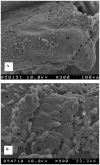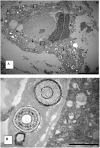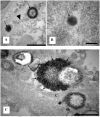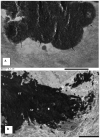Association of Randall plaque with collagen fibers and membrane vesicles
- PMID: 22266007
- PMCID: PMC3625933
- DOI: 10.1016/j.juro.2011.10.125
Association of Randall plaque with collagen fibers and membrane vesicles
Abstract
Purpose: Idiopathic calcium oxalate kidney stones develop by calcium oxalate crystal deposition on Randall plaque. The mechanisms involved in Randall plaque formation are still unclear. We hypothesized that Randall plaque formation is similar to that of vascular calcification, involving components of extracellular matrix, including membrane bound vesicles and collagen fibers. To verify our hypothesis we critically examined renal papillary tissue from patients with stones.
Materials and methods: We performed 4 mm cold cup biopsy of renal papillae on 15 patients with idiopathic stones undergoing percutaneous nephrolithotomy. Tissue was immediately fixed and processed for analysis by various light and electron microscopic techniques.
Results: Spherulitic calcium phosphate crystals, the hallmark of Randall plaque, were seen in all samples examined, including in interstitium and laminated basement membrane of tubular epithelium. Large crystalline deposits were composed of dark elongated strands mixed with spherulites. Strands showed banded patterns similar to collagen. Crystal deposits were surrounded by collagen fibers and membrane bound vesicles. Energy dispersive x-ray microanalysis and electron diffraction identified the crystals as hydroxyapatite. Few kidneys were examined and urinary data were not available on all patients.
Conclusions: Results showed that crystals in Randall plaque are associated with collagen and membrane bound vesicles. Collagen fibers appeared calcified and vesicles contained crystals. Crystal deposition in renal papillae may have started with membrane vesicle induced nucleation and grown by the further addition of crystals at the periphery in a collagen framework.
Copyright © 2012 American Urological Association Education and Research, Inc. Published by Elsevier Inc. All rights reserved.
Figures










References
-
- Murshed M, McKee MD. Molecular determinants of extracellular matrix mineralization in bone and blood vessels. Curr Opin Nephrol Hypertens. 19:359. - PubMed

